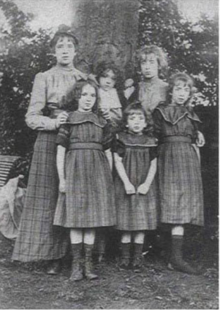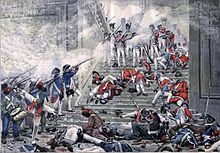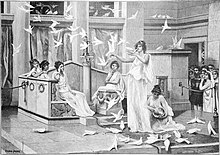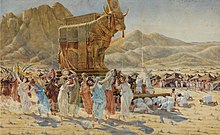Henri-Paul Motte
Henri-Paul Motte (also: Henri Motte ) (born December 15, 1846 in Paris , † March 23, 1922 in Bourg-la-Reine ) was a French history painter . His pictures mostly depict themes from antiquity or modern French history.
Life
Henri-Paul Motte, a pupil of Jean-Léon Gérôme , had his studio in Neuilly-sur-Seine near Paris (rue de Longchamps 94) and was honored with a 3rd class medal in 1880. In addition to being a painter, he was also an architect, art writer and book illustrator. He wrote a “little art history” on over 300 pages and produced a full-page illustration for each song for Emile Pessoneaux's translation of the Iliad (1886). Motte was a member of the Société des Artistes Français and also created murals; so he decorated the theater in Monte Carlo and the town hall in Limoges. Henri-Paul Motte was made a Knight of the Legion of Honor (France's highest ranking) in 1892. The 1893 World's Fair in Chicago sent Motte a wall-filling painting on canvas. He received a bronze medal at the World Exhibition in Paris in 1900 .
At the turn of the century, Henri-Paul Motte moved to Bourg-la-Reine , where he bought a large house for his large family. The property was named “Pin Ginko” (German: Pine Ginkgo ) after a tall tree in the garden . With the advent of Impressionism , it became increasingly difficult for Motte to sell his once popular paintings. That is why he also took boarders in his house.
reception
At that time, Motte's paintings were also distributed as reproductions (especially in black and white). However, only some of the originals ended up in museums. Some privately owned pictures have not appeared on the art market for decades (e.g. "The Geese on the Capitol") and must be considered lost today. Some of Motte's paintings are still popular, e.g. B. in school and history books, used for illustration.
To the painting Vercingetorix surrenders to Caesar
During the 19th century the French rediscovered their Gallic prehistory. Napoleon III had excavation campaigns carried out at the presumed site of the Battle of Alesia , and in 1885 the École nationale des beaux-arts in Paris initiated a painting competition on the subject of "The Surrender of Vercingetorix ". Motte's painting “Vercingetorix surrenders to Caesar” was created as a contribution to this competition. Motte leaned on Plutarch's report , according to which Vercingetorix rode into Caesar's camp in full armor in order to submit there. In the painting, Vercingetorix on horseback dominates the foreground, while Caesar can only be seen small in the background on a pedestal, so that here the roles of winner and loser appear almost reversed. The Roman legionaries, through whose line Vercingetorix is about to ride, look almost like a guard of honor. In doing so, Motte took up a mood that was widespread in France at the time: After the lost Franco-German War of 1870/71, people felt themselves to be proudly conquered, inferior and yet unbroken. Vercingetorix symbolizes that of Sedan in Motte Gambetta , Caesar Bismarck and the Battle of Alesia .
Familiar
Henri-Paul Motte was the son of Jean Baptiste Jules Motte (1816–1882) from Draguignan and Emile Elisa, nee. Barre (1822-1899). On December 13, 1882, Henri-Paul Motte married Constance Sarah Ivatts , the daughter of English parents, who was born in Paris in 1856. Motte and his wife had nine children and four sons ( Marcel , born 1884, died 1961 in Frederikshavn , Denmark; Lionel , born 1886; Roland , born 1898, died 1955 in Mayfield, New South Wales, Australia; Gilbert , born 1902) and five daughters ( Irène , born 1889, married Platts; Cyrille , born 1890, married Jones; Gisèle , born 1893, married Dannatt; Renée , born 1895; Odette , born 1896 ).
In addition, the Danish Sophie Lund, called "Marraine" (French for "godmother"), lived in the household; she was Head of House to Motte's daughters and was treated like family. An atmosphere of relaxed eccentricity prevailed in the Motte house . B. stated that the sons also wore long hair, which was very unusual at the time. The daughter Cyrille Motte married the English linguist Daniel Jones in 1911 . He had spent regular stays at the Motte house as a summer guest and thus got to know Cyrille. Two other daughters also married an Englishman and Odette an American.
Works (selection)
| image | Title (year of creation) | Material (in relation to the left figure) , size of the original |
Owner of the original |
|---|---|---|---|
|
The Trojan Horse (1874) |
Oil painting, 96 × 147 cm |
Original formerly at Corcoran Gallery of Art , Washington, USA; Sold at Bonhams in 2009; since 2011 at the Wadsworth Atheneum , Hartford, Connecticut, USA |
|
|
Baal devours the prisoners of war in Babylon (1876) |
Color reproduction of an oil painting |
Original in Algiers , Musée National des beaux-arts | |
|
Hannibal's army crosses the Rhône (1878) |
Black and white reproduction of an oil painting ( heliogravure from 1894) |
Original in Bagnols-sur-Cèze , Musée Albert-André | |
|
Kirke transforms Odysseus' companions into pigs (1879) |
Black and white (sepia tone) reproduction of an oil painting |
Original missing | |
|
The emperor is bored (1880) |
Oil painting, 225 × 315 cm |
Auxerre , Musée d'Art et d'Histoire | |
|
Cardinal Richelieu at the siege of La Rochelle (1881) |
Oil painting, 112 × 190.5 cm |
Musée d'Orbigny Bernon, La Rochelle | |
|
The Geese on the Capitol (1883) |
Color reproduction of an oil painting |
Original missing | |
|
The Upper Vestalin drives past (1885) |
Heliogravure after an oil painting |
Original auctioned in 1994 | |
|
The bride of Belus (around 1885) |
Oil painting, 178 × 122 cm |
formerly Galerie Vincent Lécuyer, since 2013 at the Musée d'Orsay , Paris |
|
|
Vercingetorix surrenders to Caesar (1886) |
Oil painting, 172 × 250 cm |
Musée Crozatier, Le-Puy-en-Velay | |
|
The Siege of Alesia (1888) |
Color reproduction of an oil painting |
Original in the 19th century. By Société des Sciences de Semur-en-Auxois purchased | |
|
The sacred geese of Juno (1889) |
Oil painting, 32 × 46 cm |
Auctioned at Bruun Rasmussen in 2019 | |
|
The Priestess at Delphi (1890) |
Refinished wood engraving after an oil painting |
Original missing | |
|
The Battle of Zama (around 1890) |
Black and white reproduction of an oil painting |
Original missing | |
|
The Tuileries Tower (1892) |
Color reproduction after an oil painting |
Original missing | |
|
The doves of the Temple of Venus (around 1896) |
Wood engraving after an oil painting |
Original missing | |
|
Napoleon in Aachen before the throne of Charlemagne (1898) |
Oil painting | Privately owned | |
|
The dance of the Israelites around the golden calf (1899) |
Watercolor and gouache on paper, 61 × 99 cm |
2020 offered by Bruun Rasmussen | |
|
Druid cutting mistletoe on the sixth day of the moon (1900) |
Oil painting, 116 × 80 cm |
Private collection | |
|
Leda and the Swan (undated, around 1900) |
Oil painting, 60.3 × 73.6 cm |
Auctioned at auctions in 1989 and 1996 | |
|
The last two squares in the Battle of Waterloo (1905) |
Black and white reproduction after an oil painting |
Original missing | |
|
A Banquet of Elagabal (1909) |
Black and white reproduction after an oil painting |
Original missing |
Web links
Individual evidence
- ↑ The vital dates follow the information from the National Library of France (BNF) [1] . Notwithstanding, the birthday was December 13, 1846, and the date of death was April 1, 1922 in Paris. Correct pronunciation of the name here .
- ^ Theodore Reff: World's Fair of 1889 , p. 1892. (Exhibition catalog in 47 volumes) Taylor & Francis Ltd: Milton Park 2019.
- ^ Henri Motte: Petite histoire de l'art . Paris 1896, 319 pp., Illustrated.
- ^ Iliad. Vingt-quatre grandes compositions by M. Henri Motte. Traduction by Emile Pessonneaux . Paris undated, approx. 1880 (according to BNF), 1886 according to I. Krueger. Cf. Ingeborg Krueger: Illustrated editions of Homer's Iliad and Odysee from the 16th to the 20th century , Tübingen 1971, p. 106.
- ↑ American Art News Vol. 20, no. 31 (May 13, 1922), p. 6th
- ↑ According to the BNF
- ↑ Illustration on Wikimedia Commons
- ↑ Beverly Collins, Inger M. Mees: The Real Professor Higgins: The Life and Career of Daniel Jones. Berlin: Mouton de Gruyter 1998, p. 20.
- ↑ ZB The Battle of Zama , in: Helge Hesse: Pictures tell world history . Munich 4th ed. 2013, p. 50; The geese on the Capitol , in: Adeamus. 1st edition 2016, p. 61.
- ^ Contribution of the Musée Crozatier to the painting
- ↑ Contribution to the painting on e-stoire
- ^ Family tree of the Motte family on Myheritage
- ↑ Beverly Collins, Inger M. Mees: The Real Professor Higgins: The Life and Career of Daniel Jones. Berlin: Mouton de Gruyter 1998, pp. 19-20.
- ↑ Beverly Collins, Inger M. Mees: The Real Professor Higgins: The Life and Career of Daniel Jones. Berlin: Mouton de Gruyter 1998, pp. 20, 85-87.
- ↑ https://www.invaluable.com/auction-lot/henri-paul-motte-french-1846-1922-the-trojan-horse-275-c-ylaqej4y9t
- ↑ https://www.thewadsworth.org/event/envisionfest-community-day-2016/
- ↑ https://www.pop.culture.gouv.fr/notice/joconde/01840000101
- ↑ http://www.alienor.org/collections-des-musees/fiche-objet-78591-richelieu-sur-la-digue-de-la-rochelle
- ↑ Under the title "The Parade of the Vestal Virgins", http://www.artnet.de/k%C3%BCnstler/henri-paul-motte/
- ↑ https://www.musee-orsay.fr/en/collections/index-of-works/notice.html?nnumid=165048
- ↑ https://www.musee.patrimoine.lepuyenvelay.fr/musee-crozatier/les-collections/les-oeuvres/beaux-arts/motte/
- ↑ See caption on [2]
- ↑ https://www.barnebys.de/auktionen/objekte/henri-paul-motte-scene-from-ancient-rome-with-the-sacred-geese-_7w39ql0lk
- ↑ https://bruun-rasmussen.dk/m/lots/E6F14132F260
- ↑ from: Le Petit Journal , Supplement illustré, Aug. 13, 1892, p. 264 [3]
- ↑ from: Die Gartenlaube, Heft 17/1897, p. 292 (there also more about the sacred meaning of the pigeons with the Romans) [4]
- ↑ https://bruun-rasmussen.dk/m/lots/195267EDEB07
- ↑ https://www.artrenewal.org/artworks/druids-cutting-the-mistletoe-on-the-sixth-day-of-the-moon/henri-paul-motte/3291
- ↑ http://www.e-stoire.net/article-hp-motte-druide-coupant-le-gui-au-6e-jour-de-la-lune-117835277.html
- ↑ http://www.artnet.de/k%C3%BCnstler/henri-paul-motte/
- ↑ According to Historia Augusta 21.1 (similar to 25.1), Elagabal loved to frighten his guests with tame lions and leopards, who were suddenly led into the dining room and caused panic because their harmlessness was unknown.
| personal data | |
|---|---|
| SURNAME | Motte, Henri-Paul |
| BRIEF DESCRIPTION | French history painter |
| DATE OF BIRTH | December 15, 1846 |
| PLACE OF BIRTH | Paris |
| DATE OF DEATH | March 23, 1922 |
| Place of death | Bourg-la-Reine |























